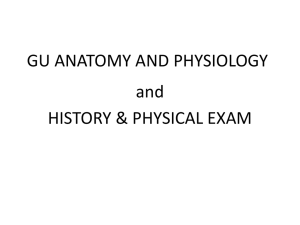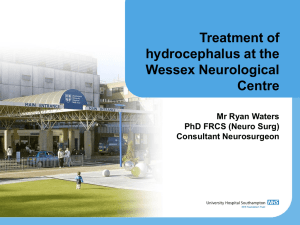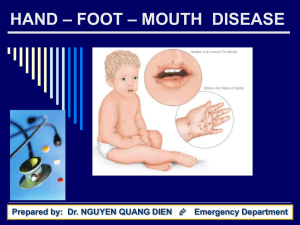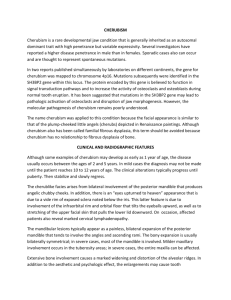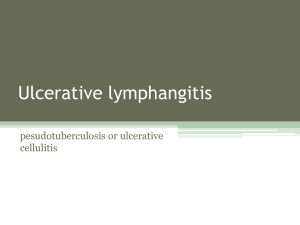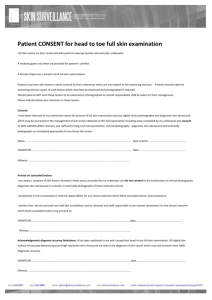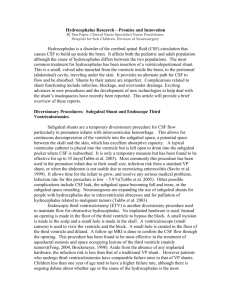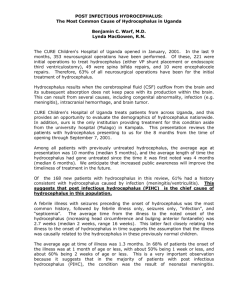Spina Bifida
advertisement
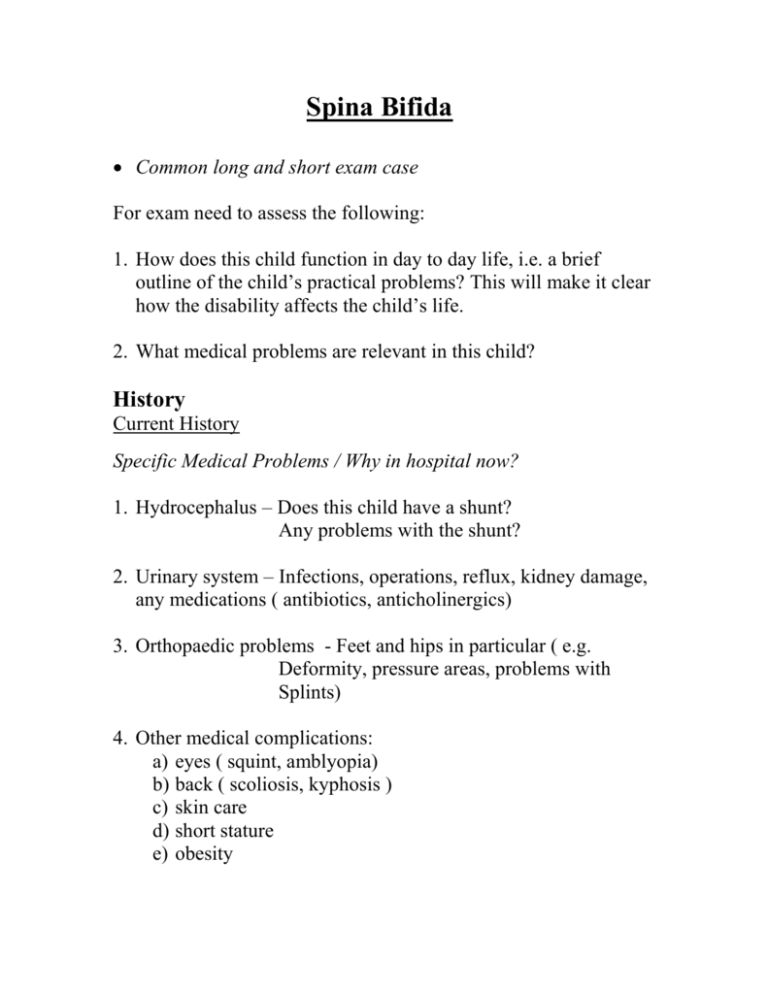
Spina Bifida Common long and short exam case For exam need to assess the following: 1. How does this child function in day to day life, i.e. a brief outline of the child’s practical problems? This will make it clear how the disability affects the child’s life. 2. What medical problems are relevant in this child? History Current History Specific Medical Problems / Why in hospital now? 1. Hydrocephalus – Does this child have a shunt? Any problems with the shunt? 2. Urinary system – Infections, operations, reflux, kidney damage, any medications ( antibiotics, anticholinergics) 3. Orthopaedic problems - Feet and hips in particular ( e.g. Deformity, pressure areas, problems with Splints) 4. Other medical complications: a) eyes ( squint, amblyopia) b) back ( scoliosis, kyphosis ) c) skin care d) short stature e) obesity How Does This Child Function? 1. Mobility - type, aids, therapy 2. Incontinence care 3. Education – What type of schooling? ( e.g. regular school, special class, special school) What particular learning problems? 4. Developmental problems – related to age ( e.g. aware of disability, making friends, self - esteem, adolescent problems of identity, independence, sexuality, employment ) How independent is this child? Past History 1. 2. 3. 4. 5. Pregnancy and birth history Antenatal screening Family history of neural tube defects Diagnosis Initial management ( counselling. Understanding of the condition and expectations for the child) 6. Early management. 7. Complications: infections, hospitalisations, operations. Social History Impact 1. On the child e.g. restricted opportunities, fewer friends, teasing, depression, poor motivation. 2. On schooling and social integration 3. On the family ( effect on siblings, marriage, financial ) What Assistance does the Family Receive? 1. Community supports: PHN, social worker, respite care, support groups, physiotherapist, O.T 2. Financial Supports Child’s Adaptation to Disability 1. What does he/she think about himself/ herself ( self- esteem) 2. Friends 3. Achievements 4. Hopes for the future Examination ( refer to diagram) Aims: 1. Demonstrate the level of the lesion 2. Functional assessment 3. Look for associated abnormalities / complications Inspection Child’s posture and spontaneous movement – describe the posture in detail, focusing on each joint systematically ( e.g.’’ flexed at hips, extended at knee’’), and noting any deformities Note the muscle bulk, comparing lower limbs with upper limbs Observe the child’s movements, LL vs UL Inspect the head – size ( hydrocephalus from Arnold-Chiari Malformation (ACM) ) and any obvious shunts Eyes – squint, nystagmus ( either can occur with ACM ) Scan the abdomen for any scars ( VP shunts) Back – site of lesion, size of repair scar, Scoliosis or scars ( fixation rods for kyphoscoliosis) Pressure sores Check centiles - large head ( hydrocephalus) - height usually decreases (short back, short lower limbs) - weight usually increased ( obese for height) Respiratory signs – Stridor ( severe ACM ) - Apnoea ( severe ACM ) - Tachypnoea ( aspiration pneumonia, Cardiac failure) Lower Limbs Start at lower limbs unless directed otherwise by examiners. Inspection: as above ( muscle bulk, wasting, deformity( i.e. talipes, dislocated hips), contractures, scars ( tendon releases, transfers), spontaneous movement Palpation: Muscle bulk ( each muscle compartment) Check tone, power, reflexes Joint movement Hip ( e.g. fixed flexion deformity; check for dislocation last) Knee ( e.g. fixed hyperextension ) Ankle ( e.g. fixed dorsiflexion) Sensation: demonstrate the sensory level Systems Exam Abdomen, then chest, upper limb, head and neck Offer to check blood pressure Functional Assessment Older Children: Activities of daily living ( reading, writing, using a knife, fork, spoon, comb, tooth brush) Ability to attend to personal hygiene ( toileting, catheterisation, menses ) Younger children: Perform a developmental assessment Additional Points 1. Hip flexion corresponds to L1, L2, so is affected in higher lesions 2. Lesions above L1 cause total paraplegia. Thus in thoracic lesions, LL’s flaccid ( frog leg posture) 3. Lesions in the high lumbar region cause child to lie in position of flexion and adduction at the hips 4. Lesions with L3 preserved allow an infant to exhibit some kicking movement 5. Hip extension corresponds to L5,S1, S2 and so is affected in all but the lower sacral lesions 6. Lesions at S3 or below completely spare lower limb sensory and motor function, but cause paralysis of bladder and anal sphincters and ‘’saddle anaesthesia’’ Management Issues Paralysis Immobility Dependence vs independence Joint contractures Loss of skin sensation Pressure necrosis of soft tissues Sphincter Disturbance Bladder Anticholinergic drugs increase bladder capacity Alpha-adrenergic drugs increase bladder outlet resistance Intermittent catheterisation can prevent residual urine retention and increase continence Incontinence clothing ( pads and pants) required in children who are unable to store any urine Monitor for UTI’s, consider prophylactic antibiotics if VUR present Surgery may be required : Bladder augmentation. Bladder neck reconstruction, Anti-reflux surgery Bowel Avoidance of constipation Regular and predictable timing of rectal emptying Dietary regulation Laxatives, suppositories and enemas may be necessary Hydrocephalus Associated problems: Increased chance of intellectual impairment Shunt complications: Obstruction, Infection, Seizures Scoliosis Impairment of balance Decreased total lung capacity Increased risk of infection Cor pulmonale Impairment of height Need for surgery ( e.g. Harrington rods ) Size Small stature Short lower limbs Obese for height Squint Associated with hydrocephalus May lead to amblyopia if untreated Genetic Counselling Parents who have one child affected with a neural tube defect have an increased risk of having a further affected child of 1 in 20. Prevention – i.e. Folic acid Antenatal screening – detailed ultrasound at 16-20 weeks - amniocentesis ( alphafetoprotein, acetylcholinesterase) * if lesion is open


